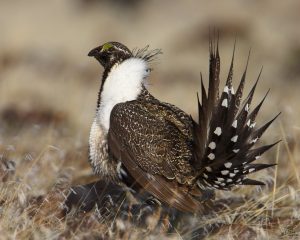USDA’s Natural Resources Conservation Service (NRCS) is accepting applications for the Regional Conservation Partnership Program (RCPP) – Livestock in Harmony with Bi-State Sage-Grouse project. This RCPP project contains two funding  streams: one from the Environmental Quality Incentives Program (EQIP) and one from the Agricultural Conservation Easement Program (ACEP). The deadline for EQIP applications for the first sign-up period is April 27, 2018. The deadline for ACEP applications for 2018 funding is also April 27, 2018.
streams: one from the Environmental Quality Incentives Program (EQIP) and one from the Agricultural Conservation Easement Program (ACEP). The deadline for EQIP applications for the first sign-up period is April 27, 2018. The deadline for ACEP applications for 2018 funding is also April 27, 2018.
The purpose of the Livestock in Harmony with Bi-State Sage-Grouse RCPP is to assist agricultural producers as they plan and adopt conservation practices that will restore sage-grouse and other wildlife habitat, improve agricultural water quality, conserve private ranchlands and upgrade agricultural infrastructure. The RCPP prioritizes those conservation practices in the Bi-State area that focus on the implementation of pasture and rangeland management practices to improve:
- Water Quality
- Wetlands
- Sage-Grouse Habitat
- Rangeland Ecosystems
PROJECT LOCATION:
The Bi-State region includes portions of Douglas, Lyon, Carson City, Mineral, and Esmeralda Counties in Nevada, and portions of Inyo, Mono, and Alpine Counties of California—in total, an area of 7,000 square miles. The Bi-State encompasses an area approximately 170 miles long and up to 60 miles wide. Private landowners, and, under some circumstances, ranchers with the authority to operate on public lands (e.g. a grazing lease or permit) are eligible for assistance. Please refer to the map for the boundaries of this RCPP.
ABOUT RCPP:
The Regional Conservation Partnership Program (RCPP) was created as part of the 2014 Farm Bill. It is not itself a fund, but a national program that provides additional funding to specific regions and projects through existing funding sources. The purpose of RCPP is to demonstrate the power of well-designed, public-private partnerships to maximize the impact of federal conservation programs. RCPP funding is entirely separate from funds allocated annually to each state by NRCS. With only 91 regions in 2018 selected throughout the country this is a big opportunity for folks located in the bi-state region.
ABOUT EQIP:
EQIP is a voluntary, conservation program administered by NRCS that can provide financial and technical assistance to install conservation practices that address natural resource concerns. The purpose of EQIP is to promote agricultural production, forest management, and environmental quality as compatible goals; to optimize environmental benefits; and to help farmers and ranchers meet Federal, State, Tribal, and local environmental regulations. A total of $765,000 has been made available for EQIP throughout the Bi-state Nevada/California region over a three- five year period. This is the first of several sign up cutoff dates.
The EQIP funds are to assist with land improvements that will help address the following resource concerns: soil erosion, soil quality degradation, insufficient water, water quality degradation, inadequate habitat for fish and wildlife, and air quality impacts.
ABOUT ACEP:
ACEP offers two easement options: Agricultural Land Easements (ALE)-Grasslands of Special Significance and Wetland Reserve Easements (WRE). A total of $7,235,000 has been made available for ACEP applicants throughout the Bi-State Nevada/California region over a three-five year period. This is the first of several sign up cutoff dates.
“Easements are important tools for landowners who are trying to conserve their land.” said Ray Dotson, acting NRCS state conservationist in California. “ACEP provides a means to keep working land in production, preserve open space, and greatly benefit our state’s natural resources and wildlife.”
Under the ALE component, NRCS may contribute up to 50 percent of the fair market value (FMV) of the agricultural land easement to protect farming and ranching on privately owned cropland. Rangeland, nonindustrial forestland, pastureland, that meet criteria as grasslands of special environmental significance may obtain up to 75% (FMV) funding level from NRCS. Approved agricultural easements prevent productive working lands from being converted to non-agricultural uses and maximize protection of land devoted to food production and critical wildlife habitats. ACEP ALE applications require an eligible entity to match NRCS funding and to hold the easement.
WRE compensates farmers, ranchers and other private landowners for land placed in wetland conservation easements held by NRCS. NRCS shares in the cost of restoring degraded wetlands. Eligible landowners can choose to enroll in a permanent or 30-year easement. Tribal landowners also have the option of enrolling in a 30-year contract. WRE also includes a Grazing Reserve Rights option which allows participants with an approved wetland and grazing management plan to enroll grazed land.
As with all ACEP easements, the landowner retains the title to the land, and the right to control access and recreational use. The land remains on the tax rolls. Learn more about EQIP and ACEP by visiting www.ca.nrcs.usda.gov/programs.
ABOUT THE PARTNERSHIP:
The Livestock in Harmony with Bi-State Sage Grouse RCPP brings together many partners: Eastern Sierra Land Trust, Eastern Sierra Audubon Society, The Nature Conservancy, Mono County Resource Conservation District, Mono County, Nevada Department of Wildlife, California Department of Fish and Wildlife, Bureau of Land Management, U.S. Forest Service, U.S. Fish and Wildlife Service – Partners for Fish and Wildlife Program, United States Geological Survey, NRCS and private landowners in an effort to leverage additional funding to conserve working ranches and farms in the Bi-State sage grouse area that borders the Eastern Sierra in Nevada and California.










